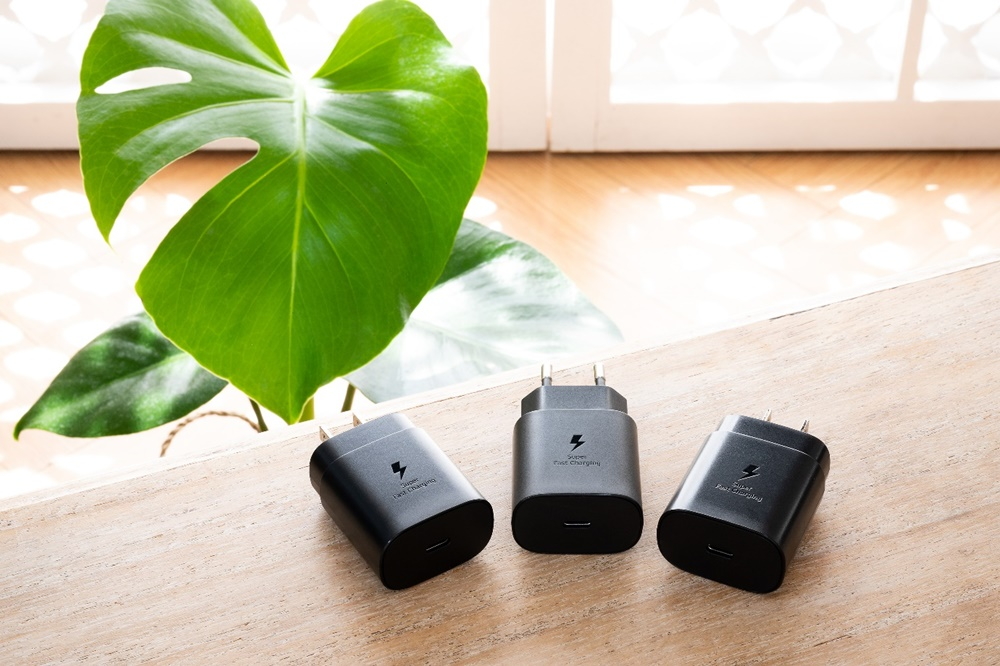
Today’s mobile devices may come in all shapes and sizes, but they share one crucial thing in common: they all need to charge.
Yes, as powerful as they’ve become, most mobile devices still require charging every day. To help prevent this daily ritual from becoming a drain on the planet, Samsung Electronics has spent the last few decades refining its charger technology to make the process as environmentally conscious as possible. This not only includes prioritizing various power-saving technologies, but also reducing the use of potentially harmful substances in the manufacturing process.
Under the belief that small adjustments to our daily routines add up to big benefits for the environment, Samsung Electronics’ Mobile Communications Business constantly explores ways to make the world a greener place. Let’s take a look at how the team is reimagining smartphone charging technology.
Tackling the Standby Issue
While many may think that once plugged-in electronics and appliances are switched off, they instantly stop consuming power, in truth, they simply enter standby mode so they can spring back to action as soon as they’re switched back on.
The same goes for our mobile devices’ chargers. Once you disconnect your device, your charger will continue to consume a considerable amount of electricity unless you unplug it from its outlet or shut down your power strip.
Standby power consumption is considered to be a major contributor to the pressing problem of power waste. In an effort to address this issue, in 2012, Samsung successfully reduced the standby power consumption of its flagship Galaxy devices’ chargers to 20mW. In the years since, the company has applied this environmentally conscious enhancement to the chargers of devices throughout its product range.
Engineer Wonseok Kang, a member of the Mobile Communications Business’s Power Solution Group, summed up both the purpose of the technology and the benefits it presents.
“In order to supply a smartphone with power as soon as it’s connected, a charger must always be ‘running,’” said Kang. “In the past, we simply kept the charger running without regulation. Now, we’ve packed software into the charger that puts it to sleep when a device is unplugged – reducing power consumption to a more environmentally conscious voltage level – and wakes the charger up when a device is connected. It’s an energy-efficient cycle of sorts.”
Efficiency Is Everything
Like standby power consumption, charging efficiency is a key determinant of just how environmentally conscious a charging technology will be. Under perfect conditions, a charger would output 100 percent of the power it receives, achieving 100-percent energy efficiency. Galaxy smartphones’ chargers offer an energy efficiency rating of over 80 percent, which meets the European Union’s standard for Level VI ErP (Energy-Related Products) certification.
Samsung’s developers went to great lengths to enhance the energy efficiency of its chargers, analyzing even the tiniest of components in an effort to maximize functionality. “We focused mainly on improving the circuits of the semiconductors that are used to convert energy,” said Kang. “In the end, we were able to reduce the cumulative electric charge by minimizing energy loss.”
The process of ensuring a consistent level of energy efficiency was challenging, to say the least. “As mobile devices evolve and battery capacities increase, charger specifications have to increase as well,” Kang explained. “From 15 watts to 25, to 45 and beyond, higher specifications require greater functionality. This inevitably leads to a decrease in average energy efficiency. However, our commitment to designing the most efficient chargers possible enabled us to deliver a high level of efficiency with likewise high specs.”
Making Galaxy smartphone chargers environmentally conscious has paid dividends for the environment, resulting in approximately 13 million kilowatts (kW) of energy savings since 2014. That’s nearly equivalent to the energy output of five hydroelectric power plants!
Save Plastic, Save the Planet
Today, the world has become so overwhelmed with plastic that the World Economic Forum (WEF) has predicted that the oceans will contain more plastic waste (by weight) than fish by the year 2050. To help tackle pollution and preserve the planet, Samsung has committed to making its innovations more sustainable, which includes maximizing the amount of recycled materials that are used to produce its smartphones’ chargers.
Galaxy smartphone chargers are produced, in part, using environmentally conscious post-consumer materials (PCM). Created by recycling the resources of previously owned products, PCM helps reduce the amount of potentially harmful substances that are created during the plastic production process. As of 2019, approximately 5,000 tons of PCM have been used to manufacture Galaxy smartphone chargers.
Samsung’s developers worked hard to ensure that adding PCM to charger designs wouldn’t compromise the overall quality of the final products. “Adding PCM can affect a product’s durability or performance,” said Pranveer Singh Rathore, a fellow engineer and colleague of Kang’s from Samsung’s Advanced CMF Lab. “However, after numerous attempts, we managed to make our designs both aesthetically pleasing and satisfyingly durable, while preserving the intrinsic properties of the substance.”
Because they directly receive electric currents, chargers are sensitive to heat, and must therefore be adequately flame retardant. As Rathore explained, “Prioritizing recycled materials and satisfying strict flame-retardancy standards at the same time was quite a challenge. However, by collaborating with various divisions and departments, we were able to come up with a method to increase the product’s quality and prevent the physical properties of the material itself from deteriorating.”
“It is never easy to go beyond the existing legal standards and design products that consider the environment – especially when other companies aren’t doing the same,” Rathore continued. “Nevertheless, I am confident that Samsung’s efforts will positively affect green initiatives going forward.”
Like his colleague, Kang sees a bright future ahead for the development of environmentally conscious mobile devices. “Raising awareness of things like smartphone chargers’ power consumption may eventually lead consumers to consider energy efficiency as an important factor when choosing a new device,” said Kang.
For those out there who are finding environmentally conscious lifestyle changes to be difficult and inconvenient, Samsung encourages you to reconsider, and hopes that efforts like these will help inspire you to do your part to make the world a greener place.
This article is written by Samsung Electronics Co., Ltd.











